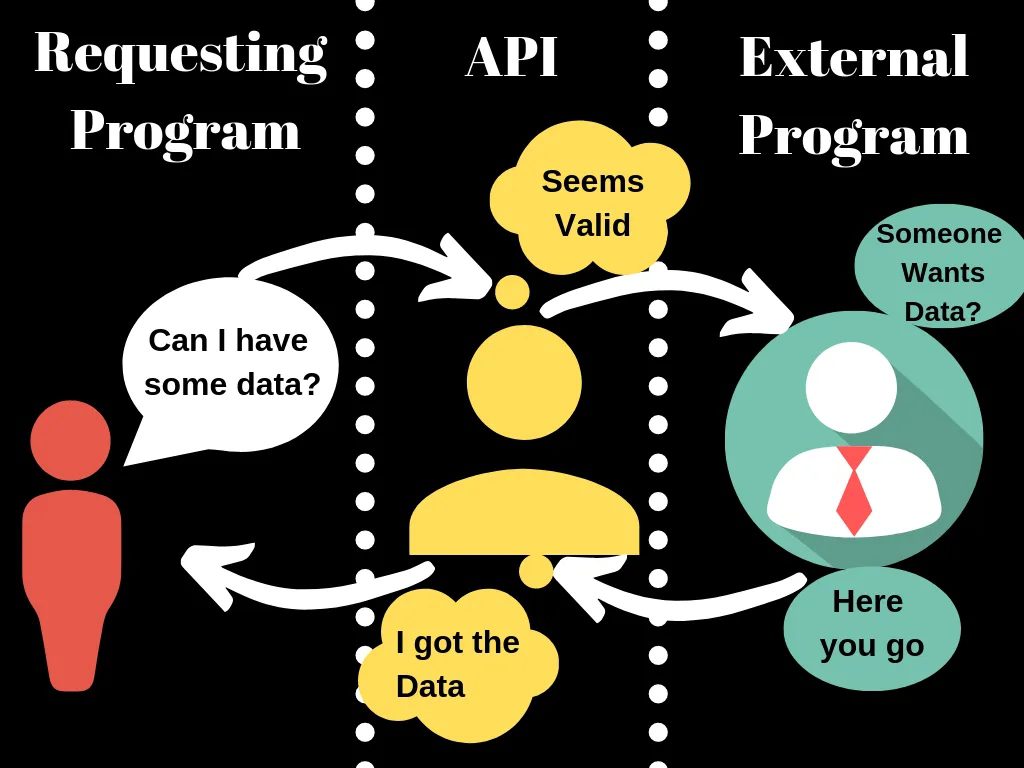In this post, you will learn about what APIs are, what API integration is, the major benefits of implementing APIs for your project, and a couple of examples to make you understand the working of APIs.
According to Postman’s “2022 State of the API Report” most businesses perceive Application Programming Interfaces or APIs, as an essential component for speedy innovation, increased partner engagement, and better customer experience.
Application Programming Interfaces (APIs) have become integral to any application development process. Digital transformation integrates various data and functions to provide rich user experiences and process automation.
Table of Contents
What are APIs?
An API is a set of protocols, definitions, and tools that allow software components to interact and communicate with one another. It enables a user to interface with a web-based application or utility. Clients can use an API to request something from an app through an interface.

The data will then be passed to an API, which will interpret the information and respond with a response. The returned data is converted by an API into something the user can understand.
Below is the image for the understanding of the API:
What is API Integration?
API integration is a connection between two or more applications that allows them to share data via their APIs. Numerous high-performing companies depend on API interfaces to keep data synchronized, increase productivity, and boost revenue.
For example, an app like Uber is enabled with an API to show the location of cabs via Google Maps. So, API integration eases a project process and benefits customers. API integration takes place digitally, without the need for human interaction.
What are the Benefits of APIs?
APIs enable projects to create solutions that improve customer experiences without increasing costs and help companies run more efficiently. The following are some of the benefits of using APIs:
1. Saves Cost
The cost of developing an app is determined by several factors, including the project’s complexity, the kind of technology used, and the developer’s experience. According to buildfire, the average cost of building and deploying an app is anywhere between $50,000 and $1,000,000
Developers can use APIs to get the majority of the functionality they need to build apps from elsewhere, rather than having to start from scratch. They can purchase cost-effective APIs from third-party suppliers or their own internal APIs instead of wasting precious resources and time reinventing the wheel.
2. Real-time Data
With the APIs, developers can easily use real-time components without writing and debugging code. With the help of real-time data, developers can also build in-demand apps like UrbanClap. Hence, with this, the companies achieve the results they need.
Businesses can stay competitive with the information they acquire by using real-time data APIs. Using APIs, they can also avoid manually searching and gather new data from a variety of sources.
3. Upgrade to Innovation
Another key benefit of API is that it helps companies upgrade their innovation. In today’s digital world, more than ever, innovation is vital to a company’s success.
The formation and maintenance of custom integrations between several applications can be costly and time-consuming. APIs encourage experimentation and innovation because of their low cost and ease of use.
APIs should be at the core of any company’s digital strategy if they wish to stay ahead of the competition. APIs enable companies to simply and securely exchange their data and services across numerous apps. Companies have a chance to improve customer experience and develop new digital services using API management tools.
According to Gartner, APIs are critical in minimizing the friction that often results from a bimodal IT strategy. APIs work as a connecting layer, allowing for a more absolute connection between the two modes, resulting in the development of innovative and feature-rich apps.
4. The Power of Data
APIs connect day-to-day operational tasks with strategic goals by integrating systems and data. It provides businesses with valuable insights into how customers are interacting with products. This data assists companies to know the right market and the right customers to target.
APIs make it possible to collect, aggregate, process, and disseminate historical and real-time data as reports, visualizations, and analytics via internal or customer-facing dashboards. API analytics gives a good understanding of the collected data so companies can pay attention to customers’ experiences and strategic business decisions.
APIs have an added benefit. Companies that have extremely valuable data can sell their valuable data as an API, which can then be monetized. And the companies that are interested in such valuable data can purchase access.
5. Increases the Launch Speed
API data and information can also be utilised to uncover new opportunities, such as developing new goods, services, and delivery models.
APIs help companies innovate faster by facilitating faster development processes. For example, if a company wants to develop a mobile app, it no longer needs to develop its mapping, payment, or communication capabilities. APIs, or plug-ins, can be used to integrate this capability into their products. As a result, development and launch times are reduced.
6. New Revenue Streams
The ability to monetize data and functionality is one of the primary advantages of using APIs for organisations. Businesses can generate new revenue streams by allowing other organisations to access and use their data and capabilities via APIs. For example, a company that collects weather data can utilise an API to allow other companies to access and use that data in their own applications and services. The company can charge a price for access to the data, generating new revenue.
Similarly, an e-commerce company can utilise APIs to grant other companies access to its inventory and pricing data, which can then be used to power alternative e-commerce platforms or price comparison websites. This might assist the organisation in expanding its reach and gaining new clients. APIs can also be used by organisations to provide premium features and services to paying clients, such as sophisticated analytics or customisation possibilities. This can aid in revenue growth and customer retention.
7. Enhanced Data Analysis
The capacity to rapidly access and analyse data from a number of sources is another advantage of using APIs for businesses. APIs may give businesses real-time data from various systems and apps, allowing them to make better decisions and improve overall performance. A company, for example, can utilise an API to access data from social media platforms in order to track customer sentiment and engagement. This can assist the company in identifying areas for improvement and making changes to better fulfil the needs of its customers.
APIs can also be used to gain access to data from other business systems such as inventory management systems, CRM systems, and financial systems. This can give organizations a more comprehensive picture of their operations and performance, allowing them to discover areas for development and make data-driven decisions. APIs can also be used to connect to third-party data sources, such as market research firms or industry reports, to get extra insights and improve decision-making.
By leveraging cloud technologies and building automated integration and deployment pipelines, APIs enable businesses to scale up quickly and easily, as well as speed up their deployment procedures.
APIs, in the end, help you solve challenges so you can achieve your digital transformation and commercial objectives.
Moreover, you can check out some of our live API integration examples below.
The Examples of API Integration
1. Get Contact Details from Active Campaign
Connect your favourite apps with the tools to get user contact details that ultimately help your projects. Our API integration with the marketing automation tool Active Campaign helps users with email marketing, email automation, Facebook custom audiences, and other specific data found in contact records.


Ultimately, it helps users leverage much of Active Campaign’s functionality. The Contacts API allows you to manage this data and sync it among Active Campaign, other tools, and your favourite apps.
API Site url: https://www.activecampaign.com/
API Document: https://developers.activecampaign.com/reference/get-contact
2. Get Real-time Gold and Silver Price from Augmont Gold
Augmont Gold is the leading online metals trading platform across India. The API integration helps them operate the gold across all platforms, which integrates the entire lifecycle of gold for a one-stop solution for retail customers.


It also enables the deposit of gold, financing against gold, and the purchase of gold and silver on an EMI basis.
What is the Future of API?
APIs can change the way of completing projects. Traditional business strategies rely on big sales forces, paperwork, and other time-consuming and costly methods to conduct their operations, and the practice is becoming increasingly unsustainable. However, powerful API integration can scale your business dynamically. For example, integrating Salesforce into your business can help you automate your sales and manage your projects efficiently.
As businesses seek to digitise their operations and offer new digital services to their guests, API integration is getting decreasingly important. The adding number of businesses moving their operations online is one of the primary factors driving the growing use of API integration.
The quantum of data generated, stored, and participated in across colourful platforms and systems has soared due to this shift. Businesses are able to connect and integrate their colourful digital systems and services thanks to APIs, which give a standard means by which colourful systems and platforms can communicate and partake data.
The growing acceptance of new technologies like the Internet of effects( IoT), pall computing, and artificial intelligence( AI) is another significant factor driving the expansion of API integration. Because these technologies induce a lot of data, new styles are demanded to connect and partake that data across colorful platforms and systems.
To produce new services like real- time analytics and prophetic modelling, for example, businesses can connect their systems and data to other platforms through APIs. They can also partake data with mates by using APIs, which makes it possible for new collaborations and business models.
Modern businesses are cutting costs and saving time by creating their solutions with best-of-breed components, which they access via APIs. According to the Harvard Business Review, Salesforce.com makes 50% of its revenue through APIs, Expedia.com makes 90%, and eBay makes 60%. APIs have numerous benefits, including the ability to create new digital products, reduce launch time to market, expand new partner opportunities, improve user experiences, and get ready for the future.


A market research study published by Custom Market Insights, the demand analysis of Global API Management Market size & share revenue was valued at approximately USD 2.8 Billion in 2021 and is expected to reach around USD 41.5 Billion by 2030, at a CAGR of 34.5% between 2022 and 2030.
Conclusion
APIs are powerful tools for enabling businesses to transform digitally and grow faster. API integration is poised to become a critical driver of digital transformation in the future. It will become increasingly crucial for organisations to connect and share data across many systems and platforms as more businesses move their operations online and adopt new technologies.
Furthermore, API integration will be critical in the creation of new business models and revenue streams based on data sharing and analysis. With data protection and security becoming increasingly important, businesses must ensure that their API integration strategies are secure and compliant with data protection standards.




